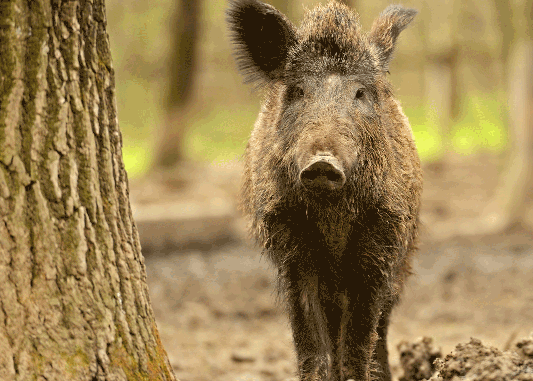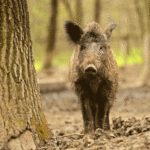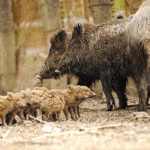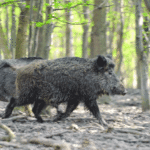
Hunting hogs in Louisiana is nothing new. Here’s a look at the tradition of hunting the ‘piney woods rooters’ that inhabit the Catahoula Lake region.
I grew up in Winn Parish and learned how to hunt while chasing squirrels in Dugdemona swamp. Whether alone or with family members, I always kept a sharp eye out for the free-ranging hogs that roamed the woods.
My father and uncles sometimes told us boys stories of being chased or treed by hogs in the old days when most of the local families kept PWRs (piney woods rooters, to the uninformed).
An annual ritual was to use dogs to catch the hogs so the family’s mark could be cut into their ear. Sometimes, things didn’t go as planned and the hogs would charge the hunters.
One of my vivid boyhood memories is sitting in Collins’ barbershop in Winnfield when I was about 10 years old. A couple old guys were talking about hog hunting, and one rolled up his pants leg to show where an enraged sow had taken a bite out of him. It looked like half his calf was gone.
Thus, it’s safe to say I was scared to death of wild hogs and always picked out a sapling to scamper up if necessary whenever I saw them in the distance.
Over time, I learned they really weren’t that dangerous, and the worst thing that ever happened was me having to shoot the ground in front of some jaw-popping sow that thought my squirrel dogs and I were a threat to her piglets.
Running hogs remains a tradition for many Winn Parish families, and the courthouse stills holds the marks that were registered many years ago.
Hog hunting, in fact, is one of those things that has helped define Louisiana for two centuries.
Several 19th and early 20th century newspapers and magazines ran stories about hunting Louisiana hogs. The Logansport (Indiana) Pharos-Tribune published the article below on Feb. 19, 1906, under the headline “Hunting Wild Hogs — It Is an Exciting Sport and Often Full of Adventure — A Fierce Attack Made on a Sportsman by a Boar in the Thickets of Lake Catahoula:”
“There are some pretty wild regions in Louisiana,” Champ Lachette of the Bayou Funny Louis (LaSalle Parish) country said to a correspondent of the Washington Post, “but none quite so wild as portions of Catahoula (P)arish. Bears are plentiful and ugly in the dense thickets, into which it is difficult for a man to work his way.
“Wildcats are common and sometimes aggressive. I heard the cry of a panther in the jungles about Lake Catahoula within the past three weeks. But of all these fierce creatures none is so fierce as the great hogs that run wild through the forests and hide and wallow in the almost impenetrable areas of canebrakes and the isolated bayou.
“These hogs are the descendants of domestic swine that came into that region with settlers when Louisiana was yet under Spanish rule, and long intimacy with the wilds and the influence of their environment have transformed them into a pugnacious and untamable race of beasts. They run in droves and, with the exception of an occasional raid on some wayback settler’s corn field or yam patch, they keep well in the depths of their haunts, where they find abundant food.
“High shouldered, big headed, long of limb, a fierce rise of bristles and a vicious eye when enraged and equipped with long, sharp tusks of ivory whiteness, the Catahoula wild hog is by no means a pleasant-looking apparition to rise before an unsuspecting hunter from a bayou wallow at the tangled roots of a cypress or emerge suddenly from the edge of a dark canebrake. That’s the way it seemed to me, at least once in my life, at any rate.
“I was bear hunting in the thicket along the west border of Lake Catahoula, and the dogs had brought a big fellow to bay twice, with the result that of the six dogs I had started out with I had but one left, and the bear was still at large. I kept on his trail, however, not yet having had a shot at him, and was in the depths of the thicket when a wild boar, with a snort that brought me up all standing, rose from some hidden resting place of his not 10 feet away and confronted me with bristles erect and his long tusks glistening on each side of his snout.
“My lone dog was not a hog dog and with recollection perhaps of lugging the ear of some lazy, tame old sow at home he sprang upon the boar before I could give him a restraining word. The mad hog received him with one vicious lunge of his big head.
“The next instant the dog was crashing through the brush, ripped open from his flank to his throat by the boar’s tusk. He gave a yelp, a gasp and a kick and joined his five companions that had fallen before the bear.
“The boar had not raised his head from this thrust at the dog when I fired at him. He fell, but was up again in a second and charged me on three legs, my bullet having had no other effect than to break one of his fore legs.
“He came with such speed that I could not fire again before he was upon me. I evaded the full force of his charge by a quick jump to one side. One of the enraged brute’s long tusks was thrust through my trousers leg between the ankle and the knee, and with a quick upward jerk of his head the boar tore the cloth open nearly to my waist. I could feel the cold rush of the tusk all the way up my leg, but the thrust had fortunately not been deep enough to enter the flesh.
“The boar had gone a pace or two beyond me in his rush, but turned and was coming at me again before I had recovered from the jar of his other assault. I fired, however, but the bullet only scraped his hide, close as he was to me.
“I had in my belt a long-bladed, sharp knife, which I used more in the way of cutting vines and tangled moss and the like to make a passage through the denser parts of the covers that characterize that region as a weapon. Dropping my gun, which was of no service to me in those close quarters, I drew the knife and, dancing about to escape the rushes of the hog, I sank the knife blade into him at every opportunity.
“This was wearying work, for, although the boar was soon covered with the blood that followed my knife thrusts and the froth that fell from his jaws was dyed with blood, he showed no signs of weakness, while I was rapidly approaching exhaustion from the constant exertion the persistent fighting of the boar made necessary. I certainly could not have held out much longer if the wild hog had kept up his assaults, but suddenly I noticed that he faltered, and at last he retired to one side of the opening, where with lowered head and glaring eyes he champed his red frothed jaws.
“I paused a little while for breath and then cautiously picked up my gun. The boar eyed me fiercely, but did not move toward me. I sent a bullet behind his ear as he stood there champing.
“He raised his big head, turned as if to rush upon me again and fell dead in his tracks. Covered with his blood and my own and my clothing in tatters, I took the shortest way homeward, leaving the carcass to the buzzards.
“I spoke of my dog not being a hog dog. If he had been one he wouldn’t have jumped at that boar. The hog dogs of Catahoula are unique.
“They are of no particular breed, but they serve a valuable purpose to the Catahoula wild hog killer.
“When the native hunter goes out after pork he constructs a roomy log corral in a locality where signs of his game are unmistakable.
“The dog is sent into the woods to rout out the drove of wild hogs. He knows well what he is to do and never forgets his training. A Catahoula wild hog hates a dog above everything else.
“When the hog dog scents his game he instantly begins to bark furiously. That brings the hogs at once toward him. When they see him and charge upon him he turns tail and runs, heading straight for the open gate of the corral, no matter how far it may be from the starting place.
“In running away he tucks his tail between his legs and assumes all the air of a badly frightened dog doing his best to get out of sight of his pursuers. He never permits himself to do so though, keeping the distance between him and the hogs not more than 25 paces.
“Should the hogs halt in the chase, satisfied that they have scared their hated enemy away, the dog returns and renews his barking, this time as if he were taunting the drove for its failure to overhaul him. This starts the hogs after the dog again fiercer than ever and he uses the same tactics as before.
“In this way he lures the hogs on until they follow him through the open gate into the corral. The dog keeps right on and jumps the fence at the farther end of the pen and disappears, but soon reappears at the front of the corral, where his master, who has been in hiding nearby runs up and closes the gate as the last hog rushes through.
“The swine are at the mercy of the hunter, who kills off at his leisure such hogs as suit him, and the unfit ones are turned loose to the woods again. A Catahoula hog killing is usually followed by feasting and festivity in the neighborhood. Wild hog hunting is seasonable from the beginning of cold weather until the return of warm.”


